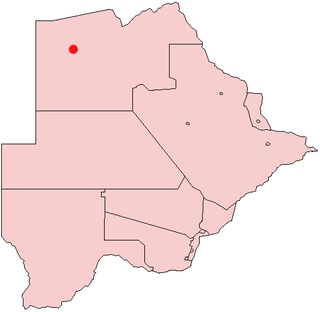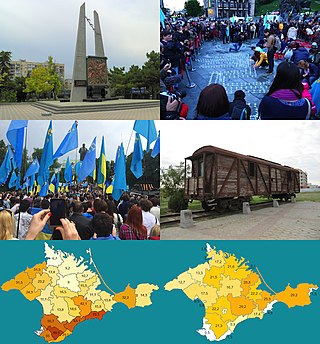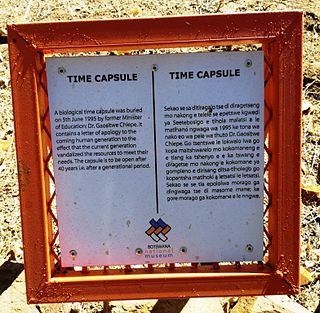Related Research Articles

Botswana, officially the Republic of Botswana, is a landlocked country in Southern Africa. Botswana is topographically flat, with approximately 70 per cent of its territory being the Kalahari Desert. It is bordered by South Africa to the south and southeast, Namibia to the west and north, and Zimbabwe to the northeast. It is connected by the Kazungula Bridge to Zambia, across the world's shortest border between two countries.

The Bechuanaland Protectorate was a protectorate established on 31 March 1885 in Southern Africa by the United Kingdom. It became the Republic of Botswana on 30 September 1966.

The Okavango Delta in Botswana is a vast inland delta formed where the Okavango River reaches a tectonic trough at an altitude of 930–1,000 m in the central part of the endorheic basin of the Kalahari. It is an UNESCO World Heritage Site as one of the few interior delta systems that do not flow into a sea or ocean, with a wetland system that is largely intact. All the water reaching the delta is ultimately evaporated and transpired. Each year, about 11 cubic kilometres (2.6 cu mi) of water spreads over the 6,000–15,000 km2 (2,300–5,800 sq mi) area. Some flood waters drain into Lake Ngami. The area was once part of Lake Makgadikgadi, an ancient lake that had mostly dried up by the early Holocene.

The Darwin Medal is one of the medals awarded by the Royal Society for "distinction in evolution, biological diversity and developmental, population and organismal biology".

Atiu, also known as Enuamanu, is an island of the Cook Islands archipelago, lying in the central-southern Pacific Ocean. Part of the Nga-pu-Toru, it is 214 km (133 mi) northeast of Rarotonga. The island's population has dropped by two-thirds in the last 50 years.

The Boteti River is a natural watercourse in Botswana. It derives flow from the core Okavango Delta through the Thamalakane River in Maun.

The North-West District or Ngamiland is one of the first-level administrative subdivisions of Botswana. For census and administrative purposes Ngamiland is subdivided into Ngamiland East, Ngamiland West and Ngamiland Delta (Okavango). It is governed by a District Commissioner, appointed by the national government, and the elected North-West District Council. The administrative centre is Maun.

Gumare or Gomare is a rural village located in the North-West District of Botswana, near the Okavango Delta. The population of Gumare was 6,067 in 2001 census, but had risen to 8,532 iby the 2011 census.

Kubu Island (Ga'nnyo) is a dry granite rock island located in the Makgadikgadi Pan area of Botswana. The island is located a few kilometers away from Orapa and Letlhakane mining towns and can be accessed through Mmatshumo in the Boteti district. The entire island is a national monument, and is considered a sacred site by the indigenous people of the area.

The deportation of the Crimean Tatars or the Sürgünlik ('exile') was the ethnic cleansing and cultural genocide of at least 191,044 Crimean Tatars carried out by the Soviet authorities from 18 to 20 May 1944, which was supervised by Lavrentiy Beria, head of Soviet state security and the secret police, and which was ordered by the Soviet leader Joseph Stalin. Within those three days, the NKVD used cattle trains to deport mostly women, children, and the elderly, even Communist Party members and Red Army members, to mostly the Uzbek SSR, several thousand kilometres away. They were one of the several ethnicities who were subjected to Stalin's policy of population transfer in the Soviet Union.
Henry Cosad Harpending was an American anthropologist and writer. He was a distinguished professor at the University of Utah, and formerly taught at Penn State and the University of New Mexico. He was a member of the National Academy of Sciences. He is known for the book The 10,000 Year Explosion, which he co-authored with Gregory Cochran.
Choiceless awareness is posited in philosophy, psychology, and spirituality to be the state of unpremeditated, complete awareness of the present without preference, effort, or compulsion. The term was popularized in mid-20th century by Indian philosopher Jiddu Krishnamurti; the concept is a central theme in his philosophy. Similar or related concepts had been previously developed in several religious or spiritual traditions. The term, or others like it, has also been used to describe traditional and contemporary meditation practices, both secular and religious. By the early 21st century,choiceless awareness as a concept or term had appeared in a variety of fields, including neuroscience, therapy, and sociology, as well as in art. However, Krishnamurti's approach to the subject was unique, and differs from both prior and later notions.
Nokaneng is a village in North-West District, Botswana. It is located close to the Okavango Delta, and is served by Nokaneng Airport. The population of Nokaneng was 1,590 in 2001 census.
Seronga is a village in North-West District, Botswana. It is located close to beginning of the Okavango Delta, and has a local airstrip. The population of Seronga was 1,641 in 2001 census. In 2011 population census, the village had a population of 3716 making it the fourth largest village in Ngamiland West. Seronga village has two government schools namely; Seronga Primary School and Ngambao Junior Secondary School. In addition, Seronga village has other government facilities namely Seronga Sub-Land Board, Seronga Police Station, Seronga Airfield, National Parks and Wildlife Office, Tribal Administration office headed by Senior Chief Representative, 24 hour Clinic with a Doctor.

The official language of Botswana is English, while Setswana is considered to be a national language. English, which was inherited from colonial rule, is the language of official business and most written communication. Most of the population speak Setswana, but over 20 smaller languages are also spoken. Some of the country's languages are in danger of becoming extinct.

Chobe District is an administrative district in the northern part of Botswana, with the headquarters in Kasane. In 2001 it was merged with Ngamiland, and until 2006 it shared with Ngamiland the North-West District Council as local government. Chobe National Park is in the Chobe District. As of 2011, the total population of the district was 23,347 compared to 18,258 in 2001. The growth rate of population during the decade was 2.49. The total number of workers constituted 12,059 with 6,113 males and 5,947 females, with majority of them working in public administration.
Ancestral land conflict over the Central Kalahari Game Reserve (CKGR) arose in the 1970s between the government of Botswana and the San people (Bushmen), and is ongoing, resulting in one of the most expensive court cases in the history of Botswana.
Jackson Mutero Chirenje was a Zimbabwean historian. He was born in Mudzimuirema, Chihota, Rhodesia. He served as Secretary of the African Teachers' Union of Rhodesia in 1961. He received a B.A. in history from Boston University, an M.A. in history from the University of California at Los Angeles and a PhD. in history from University of London. He taught African history, African philosophy and Afro-American history at Harvard University. He was a senior lecturer and chairman of the history department at the University of Zimbabwe.
Ngamiland West is one of the subdistricts of Ngamiland District of Botswana.
Tsheko Tsheko (1923–1969) was a Motswana politician. He was a member of the National Assembly of Botswana from 1965 to 1969, where he served in the Cabinet of Botswana.
References
- ↑ McIntyre, Chris (April 1, 2014). Botswana Safari Guide: Okavango Delta, Chobe, Northern Kalahari. Bradt Travel Guides. ISBN 9781841624891 – via Google Books.
- ↑ Potten, David (1976). "Etsha: A Successful Resettlement Scheme". Botswana Notes and Records. 8: 105–119. JSTOR 40979461 – via JSTOR.
- ↑ Elizabeth Terry, M. (1984). "A Survey of Basketmakers, Etsha, Ngamiland, Botswana".
- ↑ "Botswana Notes and Records". Botswana Society. September 2, 2000 – via Google Books.
- ↑ Cunningham, Anthony B. (October 14, 2014). Applied Ethnobotany: People, Wild Plant Use and Conservation. Taylor & Francis. ISBN 9781136534669 – via Google Books.
- ↑ Campbell, Bruce Morgan; Luckert, Martin Karl (September 2, 2002). Uncovering the Hidden Harvest: Valuation Methods for Woodland and Forest Resources. Earthscan. ISBN 9781853838095 – via Google Books.
- ↑ "Distribution of population by sex by villages and their associated localities: 2001 population and housing census". Archived from the original on 2007-11-24.
19°06′47″S22°17′48″E / 19.11306°S 22.29667°E